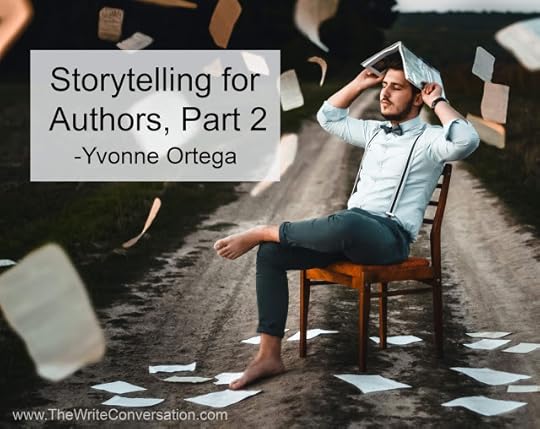Storytelling for Authors, Part 2

by Yvonne Ortega @YvonneOrtega1
Get caught up on Storytelling for Authors, Part 1 , here . In part 1, I covered the first three Cs of storytelling for authors:Curiosity Circumstance Characters ConflictConflict is the fourth C of storytelling for author presentations. It involves a struggle between two opposing forces, usually a protagonist and an antagonist. The conflict can also be an internal struggle or between a character and nature. The internal struggle can be between good and evil or virtue and vice.
With COVID-19, the media reports stories every day about how we are handling the pandemic. Research past pandemics: Black Death (Bubonic Plague), Smallpox, 17th Century Great Plagues, 18th Century Great Plagues, Yellow Fever, HIV/AIDS, Spanish Flu, Russian Flu, Asian Flu, SARS, Swine Flu, or Ebola. You can present stories to compare and contrast your experiences with one or two of them.
Escalate the conflict. The escalation entices the audience to listen and want to find out what happens. If you tell a story next year about life during the pandemic, you can start with your initial shock and self-pity. Then escalate as more events were cancelled and businesses closed.
Conversations in DialogueTo intensify the conflict, add dialogue. If you only narrate, your story might sound more like a report. If you use only dialogue, you have a stage play. Combine both narration and dialogue. Conversations are dialogue but to keep the speaking tips all Cs, I use the phrase conversations in dialogue.
In my presentation on Moving from Broken to Beautiful® through Grief, Mr. Not Nice phoned me and said, “You don’t have to go to California for Brian’s [our son’s] memorial service. You can have your own service in Virginia.”
Why would he tell me something like that? “I’m my only child’s mother, and I will be there.”
After a pause, I also said, “I want to give a eulogy.”“His girlfriend and his boss are giving one.”
What difference did that make? “It’s my right as the mother to give a eulogy.”
CureThe cure is the sixth C of storytelling for authors in presentations. The cure is the remedy, the solution, the relief. The guru or hero offers the cure and serves as teacher, counselor, or mentor. A book can also be the hero. You and I cannot fulfill that role. The audience would think we’re perfect or special. That would leave them without hope of a cure in their lives.
In my presentation, How to Forgive When You Don’t Want to, my Sunday school teacher served as my mentor. She said, “Forgive your estranged husband not for him but for your own good.”
ChangeThe fifth C of storytelling is change. Show the emotional change for the better. “Since I forgave my estranged husband, I can eat and delight in every morsel on my plate. I sleep until morning without waking up. The headaches, back pain, and isolation ended.”
In the change, show that the character looks surprised and grateful. “When I saw my Sunday school teacher, I grinned, leaped for joy, and said, ‘Forgiveness works.’ I hugged her and laughed.”
What emotional change for the better have you made? How will you show it?
CarryoutThe carryout is what the guru taught you, the message of your story.
My forgiveness carryout is “Forgiveness is for your own good.”
CallbackIn the callback, you call back to the hero or to a story in the introduction or elsewhere in your presentation. Then challenge or give the audience a call to action.
In my forgiveness presentation, I call back to the story of making black belt. “In the beginning, I said, ‘I broke the boards because I saw my estranged husband’s face on them.’ Now I pray for him and his new family.”
“Whom will you forgive this week for your own good?”
In conclusion, the 6 Cs of storytelling we covered in Part 2 are:Conflict-a struggle between two opposing forcesConversations in Dialogue-the combination of dialogue and narration throughout the storyCure-the remedy, the solution, the relief from another person or a bookChange-the emotional change for the betterCarryout-what the guru taught you, the message of your storyCallback-the call back to the hero or a story from the introduction or elsewhereTWEETABLE Storytelling for Authors, Part 2 - @YvonneOrega1 on @EdieMelson (Click to Tweet)
 Yvonne Ortega walks with a small footprint but leaves a giant imprint in people’s lives. This power-packed package is a professional speaker and the author of the Moving from Broken to Beautiful® Series through cancer, divorce, forgiveness, and loss. Learn more at www.YvonneOrtega.com
Yvonne Ortega walks with a small footprint but leaves a giant imprint in people’s lives. This power-packed package is a professional speaker and the author of the Moving from Broken to Beautiful® Series through cancer, divorce, forgiveness, and loss. Learn more at www.YvonneOrtega.comYvonne speaks with honesty and humor as she shares her life and struggles through presentations that empower women to find peace, power, and purpose through God’s Word.
Yvonne’s background as a licensed professional counselor brings a unique perspective into the heart of women. She’s a speaking and writing coach and the owner of Moving from Broken to Beautiful®, LLC. She belongs to the Advanced Writers and Speakers Association, the Christian Authors Network, the National Speakers Association, and Toastmasters International.
She celebrates life at the beach, where she walks, builds sand castles, blows bubbles, and dances.
Published on April 12, 2020 22:00
No comments have been added yet.



